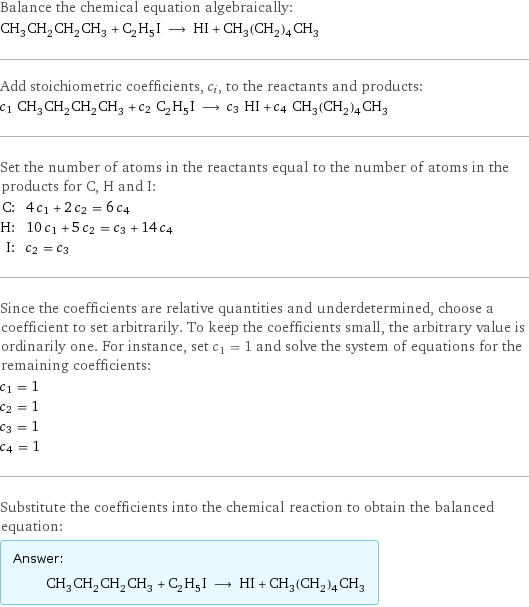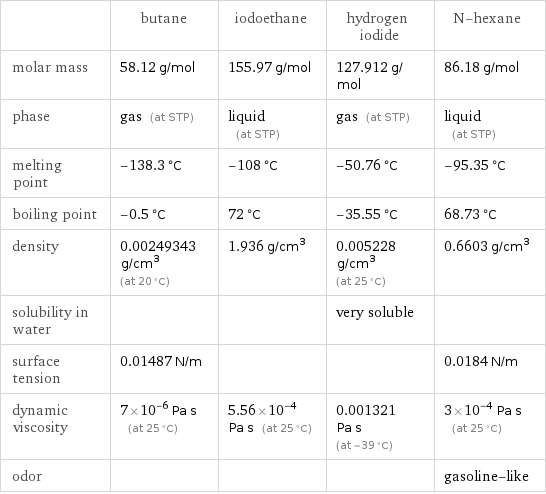Input interpretation

CH_3CH_2CH_2CH_3 butane + C_2H_5I iodoethane ⟶ HI hydrogen iodide + CH_3(CH_2)_4CH_3 N-hexane
Balanced equation

Balance the chemical equation algebraically: CH_3CH_2CH_2CH_3 + C_2H_5I ⟶ HI + CH_3(CH_2)_4CH_3 Add stoichiometric coefficients, c_i, to the reactants and products: c_1 CH_3CH_2CH_2CH_3 + c_2 C_2H_5I ⟶ c_3 HI + c_4 CH_3(CH_2)_4CH_3 Set the number of atoms in the reactants equal to the number of atoms in the products for C, H and I: C: | 4 c_1 + 2 c_2 = 6 c_4 H: | 10 c_1 + 5 c_2 = c_3 + 14 c_4 I: | c_2 = c_3 Since the coefficients are relative quantities and underdetermined, choose a coefficient to set arbitrarily. To keep the coefficients small, the arbitrary value is ordinarily one. For instance, set c_1 = 1 and solve the system of equations for the remaining coefficients: c_1 = 1 c_2 = 1 c_3 = 1 c_4 = 1 Substitute the coefficients into the chemical reaction to obtain the balanced equation: Answer: | | CH_3CH_2CH_2CH_3 + C_2H_5I ⟶ HI + CH_3(CH_2)_4CH_3
Structures

+ ⟶ +
Names

butane + iodoethane ⟶ hydrogen iodide + N-hexane
Equilibrium constant
![Construct the equilibrium constant, K, expression for: CH_3CH_2CH_2CH_3 + C_2H_5I ⟶ HI + CH_3(CH_2)_4CH_3 Plan: • Balance the chemical equation. • Determine the stoichiometric numbers. • Assemble the activity expression for each chemical species. • Use the activity expressions to build the equilibrium constant expression. Write the balanced chemical equation: CH_3CH_2CH_2CH_3 + C_2H_5I ⟶ HI + CH_3(CH_2)_4CH_3 Assign stoichiometric numbers, ν_i, using the stoichiometric coefficients, c_i, from the balanced chemical equation in the following manner: ν_i = -c_i for reactants and ν_i = c_i for products: chemical species | c_i | ν_i CH_3CH_2CH_2CH_3 | 1 | -1 C_2H_5I | 1 | -1 HI | 1 | 1 CH_3(CH_2)_4CH_3 | 1 | 1 Assemble the activity expressions accounting for the state of matter and ν_i: chemical species | c_i | ν_i | activity expression CH_3CH_2CH_2CH_3 | 1 | -1 | ([CH3CH2CH2CH3])^(-1) C_2H_5I | 1 | -1 | ([C2H5I])^(-1) HI | 1 | 1 | [HI] CH_3(CH_2)_4CH_3 | 1 | 1 | [CH3(CH2)4CH3] The equilibrium constant symbol in the concentration basis is: K_c Mulitply the activity expressions to arrive at the K_c expression: Answer: | | K_c = ([CH3CH2CH2CH3])^(-1) ([C2H5I])^(-1) [HI] [CH3(CH2)4CH3] = ([HI] [CH3(CH2)4CH3])/([CH3CH2CH2CH3] [C2H5I])](../image_source/2472a3e2b3e5dbd43d1583d683ca4b30.png)
Construct the equilibrium constant, K, expression for: CH_3CH_2CH_2CH_3 + C_2H_5I ⟶ HI + CH_3(CH_2)_4CH_3 Plan: • Balance the chemical equation. • Determine the stoichiometric numbers. • Assemble the activity expression for each chemical species. • Use the activity expressions to build the equilibrium constant expression. Write the balanced chemical equation: CH_3CH_2CH_2CH_3 + C_2H_5I ⟶ HI + CH_3(CH_2)_4CH_3 Assign stoichiometric numbers, ν_i, using the stoichiometric coefficients, c_i, from the balanced chemical equation in the following manner: ν_i = -c_i for reactants and ν_i = c_i for products: chemical species | c_i | ν_i CH_3CH_2CH_2CH_3 | 1 | -1 C_2H_5I | 1 | -1 HI | 1 | 1 CH_3(CH_2)_4CH_3 | 1 | 1 Assemble the activity expressions accounting for the state of matter and ν_i: chemical species | c_i | ν_i | activity expression CH_3CH_2CH_2CH_3 | 1 | -1 | ([CH3CH2CH2CH3])^(-1) C_2H_5I | 1 | -1 | ([C2H5I])^(-1) HI | 1 | 1 | [HI] CH_3(CH_2)_4CH_3 | 1 | 1 | [CH3(CH2)4CH3] The equilibrium constant symbol in the concentration basis is: K_c Mulitply the activity expressions to arrive at the K_c expression: Answer: | | K_c = ([CH3CH2CH2CH3])^(-1) ([C2H5I])^(-1) [HI] [CH3(CH2)4CH3] = ([HI] [CH3(CH2)4CH3])/([CH3CH2CH2CH3] [C2H5I])
Rate of reaction
![Construct the rate of reaction expression for: CH_3CH_2CH_2CH_3 + C_2H_5I ⟶ HI + CH_3(CH_2)_4CH_3 Plan: • Balance the chemical equation. • Determine the stoichiometric numbers. • Assemble the rate term for each chemical species. • Write the rate of reaction expression. Write the balanced chemical equation: CH_3CH_2CH_2CH_3 + C_2H_5I ⟶ HI + CH_3(CH_2)_4CH_3 Assign stoichiometric numbers, ν_i, using the stoichiometric coefficients, c_i, from the balanced chemical equation in the following manner: ν_i = -c_i for reactants and ν_i = c_i for products: chemical species | c_i | ν_i CH_3CH_2CH_2CH_3 | 1 | -1 C_2H_5I | 1 | -1 HI | 1 | 1 CH_3(CH_2)_4CH_3 | 1 | 1 The rate term for each chemical species, B_i, is 1/ν_i(Δ[B_i])/(Δt) where [B_i] is the amount concentration and t is time: chemical species | c_i | ν_i | rate term CH_3CH_2CH_2CH_3 | 1 | -1 | -(Δ[CH3CH2CH2CH3])/(Δt) C_2H_5I | 1 | -1 | -(Δ[C2H5I])/(Δt) HI | 1 | 1 | (Δ[HI])/(Δt) CH_3(CH_2)_4CH_3 | 1 | 1 | (Δ[CH3(CH2)4CH3])/(Δt) (for infinitesimal rate of change, replace Δ with d) Set the rate terms equal to each other to arrive at the rate expression: Answer: | | rate = -(Δ[CH3CH2CH2CH3])/(Δt) = -(Δ[C2H5I])/(Δt) = (Δ[HI])/(Δt) = (Δ[CH3(CH2)4CH3])/(Δt) (assuming constant volume and no accumulation of intermediates or side products)](../image_source/f4e1b12471a7bdc93724031a7f0338c3.png)
Construct the rate of reaction expression for: CH_3CH_2CH_2CH_3 + C_2H_5I ⟶ HI + CH_3(CH_2)_4CH_3 Plan: • Balance the chemical equation. • Determine the stoichiometric numbers. • Assemble the rate term for each chemical species. • Write the rate of reaction expression. Write the balanced chemical equation: CH_3CH_2CH_2CH_3 + C_2H_5I ⟶ HI + CH_3(CH_2)_4CH_3 Assign stoichiometric numbers, ν_i, using the stoichiometric coefficients, c_i, from the balanced chemical equation in the following manner: ν_i = -c_i for reactants and ν_i = c_i for products: chemical species | c_i | ν_i CH_3CH_2CH_2CH_3 | 1 | -1 C_2H_5I | 1 | -1 HI | 1 | 1 CH_3(CH_2)_4CH_3 | 1 | 1 The rate term for each chemical species, B_i, is 1/ν_i(Δ[B_i])/(Δt) where [B_i] is the amount concentration and t is time: chemical species | c_i | ν_i | rate term CH_3CH_2CH_2CH_3 | 1 | -1 | -(Δ[CH3CH2CH2CH3])/(Δt) C_2H_5I | 1 | -1 | -(Δ[C2H5I])/(Δt) HI | 1 | 1 | (Δ[HI])/(Δt) CH_3(CH_2)_4CH_3 | 1 | 1 | (Δ[CH3(CH2)4CH3])/(Δt) (for infinitesimal rate of change, replace Δ with d) Set the rate terms equal to each other to arrive at the rate expression: Answer: | | rate = -(Δ[CH3CH2CH2CH3])/(Δt) = -(Δ[C2H5I])/(Δt) = (Δ[HI])/(Δt) = (Δ[CH3(CH2)4CH3])/(Δt) (assuming constant volume and no accumulation of intermediates or side products)
Chemical names and formulas

| butane | iodoethane | hydrogen iodide | N-hexane formula | CH_3CH_2CH_2CH_3 | C_2H_5I | HI | CH_3(CH_2)_4CH_3 Hill formula | C_4H_10 | C_2H_5I | HI | C_6H_14 name | butane | iodoethane | hydrogen iodide | N-hexane IUPAC name | butane | iodoethane | hydrogen iodide | hexane
Substance properties

| butane | iodoethane | hydrogen iodide | N-hexane molar mass | 58.12 g/mol | 155.97 g/mol | 127.912 g/mol | 86.18 g/mol phase | gas (at STP) | liquid (at STP) | gas (at STP) | liquid (at STP) melting point | -138.3 °C | -108 °C | -50.76 °C | -95.35 °C boiling point | -0.5 °C | 72 °C | -35.55 °C | 68.73 °C density | 0.00249343 g/cm^3 (at 20 °C) | 1.936 g/cm^3 | 0.005228 g/cm^3 (at 25 °C) | 0.6603 g/cm^3 solubility in water | | | very soluble | surface tension | 0.01487 N/m | | | 0.0184 N/m dynamic viscosity | 7×10^-6 Pa s (at 25 °C) | 5.56×10^-4 Pa s (at 25 °C) | 0.001321 Pa s (at -39 °C) | 3×10^-4 Pa s (at 25 °C) odor | | | | gasoline-like
Units
